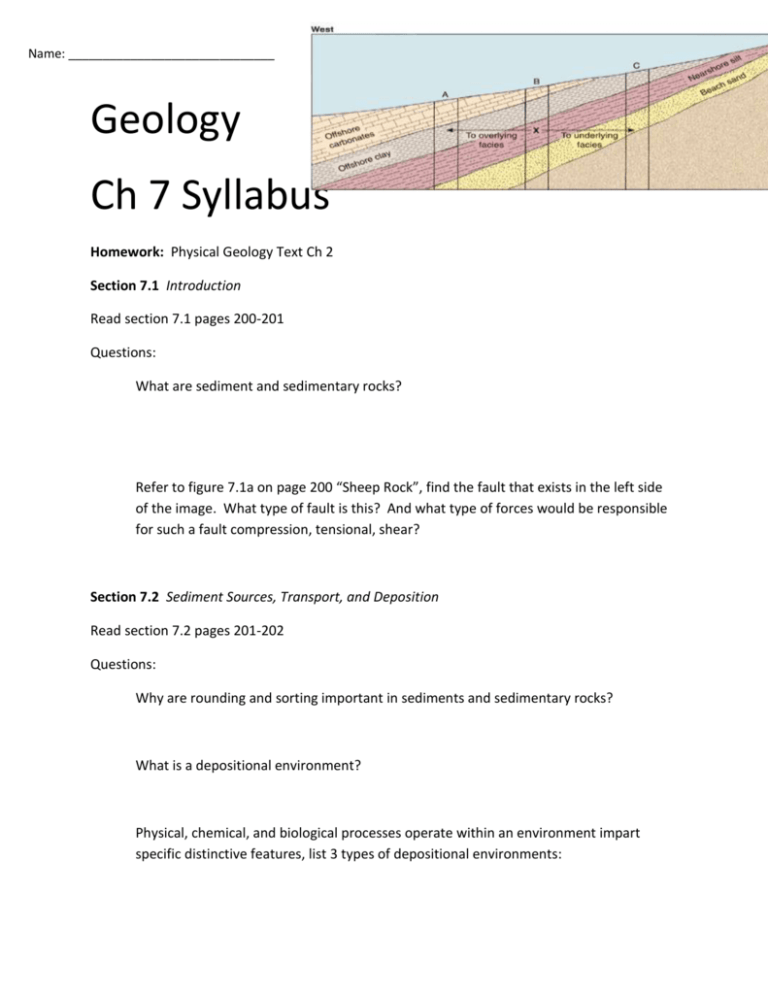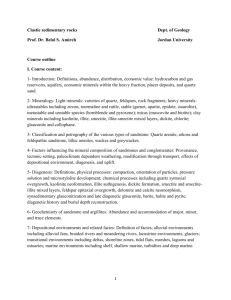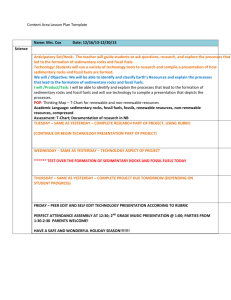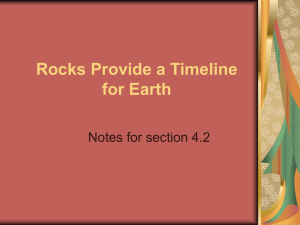Geology - Perry Local Schools
advertisement

Name: ______________________________ Geology Ch 7 Syllabus Homework: Physical Geology Text Ch 2 Section 7.1 Introduction Read section 7.1 pages 200-201 Questions: What are sediment and sedimentary rocks? Refer to figure 7.1a on page 200 “Sheep Rock”, find the fault that exists in the left side of the image. What type of fault is this? And what type of forces would be responsible for such a fault compression, tensional, shear? Section 7.2 Sediment Sources, Transport, and Deposition Read section 7.2 pages 201-202 Questions: Why are rounding and sorting important in sediments and sedimentary rocks? What is a depositional environment? Physical, chemical, and biological processes operate within an environment impart specific distinctive features, list 3 types of depositional environments: Name: ______________________________ Section 7.3 Lithification: Converting Sediment into Sedimentary Rock Read section 7.3 pages 203-204 Questions: Describe the process of lithification of sediment. What two processes bring about the lithification of sediment? Describe the process of cementation within sedimentary rocks. What are the four most common cements in sedimentary rocks and their chemical formulas? Circle the most common of these four. Which two cements account for the reds, yellows, and browns typically seen in sedimentary rocks found in many areas? How would one distinguish the difference between a rock samples that were cemented by calcium carbonate versus silicon dioxide in the field? Section 7.4 The Types of Sedimentary Rocks Read section 7.4 pages 204-210 Questions: Describe detrital sedimentary rocks, and how these rocks are primarily classified. Refer to Figure 7.5 on page 205, how would one differentiate between a Conglomerate and sedimentary Breccia in the field or laboratory sample? Name: ______________________________ Sandstone is a rock made up of sand, to be identified as a sandstone it must meet this specific criteria. Sandstone forms in several depositional environments, list six such environments. Mudrock is a general term that encompasses detrital sedimentary rocks composed of silt and clay sized particles. Mudrocks make up about 40% of all sedimentary rocks making them more abundant than conglomerates and sandstones. Describe the types of depositional environments we would find mudrocks and how the sediments that form mudrocks are transported there. Refer to table 7.1 “Classification of Chemical and Biochemical Sedimentary Rocks” on pg. 207 to complete the table below: Composition + formula Rock Name Chemical or Biochemical Carbonate or Sedimentary Rock Evaporite Give a brief description of Coal. In what type of environment would coal form? Name: ______________________________ Peat contains 50% carbon is the first step in the formation of coal, what are the three other phases which coal goes through during its formation, list their % carbon for each type. Of these three phases of coal which one would you suspect is the most useful to society both efficiently and monetarily. The United States uses about 860 million metric tons of coal per year from its reserve of 243 billion metric tons. Assuming that all of this coal can be mined, how long will it last at the current rate of consumption? Must show your work ____________ Answer Why is it improbable that all of this reserve can ever be mined? This map shows where coal is found in the United States. The information below tells which states mine coal and how much they produced in 1993. Name: ______________________________ Ch 7 Syllabus Part Two Section 7.5 Sedimentary Facies Read section 7.5 pages 210-212 Questions: What are sedimentary facies and what criteria do geologists use to define a sedimentary facies. Refer to Figure 7.12 on page 211, it shows a sandstone facies, a shale facies, and a limestone facies. Geologists can use this information listed in the table above to infer what type of environment these sediments were deposited in. Complete the table below: Facies Type (rock type) Deposition (near shore/offshore) Energy (high/low) Limestone Shale Sandstone Marine transgression is when sea level rises relative to the land, refer to the bottom of figure 7.12 on page 211. Evidence for a marine transgression can be found in the rock record, by examining sedimentary facies. List in order from bottom (old land surface) to top the sedimentary facies that would exist in a marine transgression sequence related depositional environments. Old land surface (rock type) Deposition near shore/offshore Name: ______________________________ Marine regression is when sea level falls relative to the land, refer to the bottom of figure 7.12 on page 211. Evidence for a marine regression can be found in the rock record, by examining sedimentary facies. List in order from bottom (old land surface) to top the sedimentary facies that would exist in a marine regression sequence and their related depositional environments. Old land surface (rock type) Deposition near shore/offshore Refer to Figure 7.13 on page 212; this is a view of the Tapeats Sandstone, Bright Angle Shale, and Muav Limestone in the Grand Canyon in Arizona. Do these sedimentary facies represent that of a marine transgression or marine regression? There are 6 main causes to marine transgressions and regressions in the table below list each in the appropriate column: Marine Transgressions (sea level rises) Marine Regressions (sea level falls) Name: ______________________________ Section 7.6 Sedimentary Facies Read section 7.6 pages 212-218 Questions: Sedimentary rocks acquire their characteristics from the physical, biological, and chemical processes that operated in the depositional environment. How does the sorting of sediments in windblown sand dunes compare to deposits of glaciers? Rock salt and gypsum would be related to what type of depositional environment? What are geologists referring to when they speak of “strata or beds”? What are geologists referring to when they speak of “bedding plane”? What are paleocurrents and what are they a good indication of? What is cross bedding, and what types of environments are associated with strata that would have this feature. Refer to Figure 7.14 on page 213; This diagram represents something called cross bedding, look at image (b) to wee what cross bedding looks like at Natural Bridges in Utah. Make a sketch to representing how to determine wind or current direction within a sedimentary deposit like the one in Figure 7.14 (a). Name: ______________________________ Refer to figure 7.17 on page 215, these represent wave ripple marks, how do they differ from the cross bedding structures you just drew above? Figuring Out the Environment of Deposition; Are you justified in using present day processes and deposits to make inferences about what happened when no human observers were present? How do Geologists determine the depositional environments of ancient sedimentary rocks? No one was present millions of years ago to record data about the climate, the fauna and flora, the geography, and geological processes. So how is it possible to decipher unobserved past events? In other words, what features in sedimentary rocks would you look for to determine what happened during the distant past? Cite examples from things you learned in this chapter. Congrats you just finished Ch 7 now we are ready for the HW Test and Ch 7 Exam. Name: ______________________________








